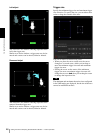
Others
Glossary
56
Network bandwidth
Bit rate that can be used for networking.
NTP server
Network time server that transmits and receives time
information over the networks.
Primary DNS server
One of the DNS servers that can first reply to a request
by connected devices or other DNS servers.
Proxy server
A server or software that acts as an intermediary
between a local network and the Internet so that it can
connect to the Internet in place of a computer on a local
network.
Saturation
The degree to which a color is pure.
Secondary DNS server
Subsidiary DNS server used when a primary DNS server
cannot be used.
Sharpness
The degree to which the boundary of two portions is
clearly distinguished.
SMTP Server
A server for sending or relaying e-mail messages
between servers.
Solid PTZ
Zooming in/out function of an image without using an
optical zooming function.
SSL
Acronym for Secure Sockets Layer. This is a protocol
developed by Netscape Communications Corporation to
be used for communications of encrypted data on the
Internet.
Subnet mask
32-bit stream used to distinguish the subnet address
from an IP address.
TCP
Acronym for Transmission Control Protocol. A standard
protocol used for Internet connection. Compared with
the other protocol, UDP, TCP provides reliable
communication but communication speed is slower.
UDP
Acronym for User Datagram Protocol. A standard
protocol used for Internet connection. Compared with
the other protocol, TCP, UDP can transmit data faster,
but reliable communication is not guaranteed.
Unicast
Transmission of data to specified equipment on a
network by specifying a single address.
VBR
VBR stands for Variable Bit Rate control. When you
select this setting, the bit rate will be adjusted to suit the
camera scene.
WEP
WEP stands for Wired Equivalent Privacy. It is
encryption, compliant with the IEEE802.11 standard.
WPA
WPA stands for Wi-Fi Protected Access. It is a standard
for encryption developed by Wi-Fi Alliance, the trade
group of wireless LAN.
This encryption function compensates for WEP (Wired
Equivalent Privacy) flaws.
WPA2
WPA2 stands for Wi-Fi Protected Access 2. It is a
standard for encryption developed by Wi-Fi Alliance,
the trade group of wireless LAN.
This encryption function has more strength than WPA.


















